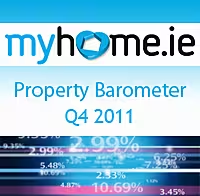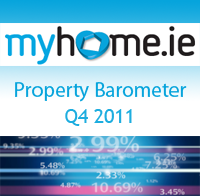
- Annual rate of decline for 2011 was 13%
- Asking prices decline moderates to 2.4% in Q4
- Average asking price nationally is now €236K - 43% down from peak
- Transaction prices are now back at 2000 levels in Dublin
- Report Downloads
Monday 2nd January 2012. House prices declined by 2.4% in the last quarter and by 13% overall in 2011according to the latest figures from leading property website MyHome.ie.
The 2.4% fall in the average mix-adjusted asking price was the slowest rate of quarterly decline in two and a half years. In Dublin prices declined by 2.8% in the last quarter while the annual rate of decline in the capital was 14.7%.
Asking prices nationally are now down by 43% compared to the peak - Q3 2006 - while Dublin prices are down 50% over the same period.
Based on average mix-adjusted asking prices, the average price for a home nationally is now €236K as opposed to €241K three months ago. In Dublin the corresponding figures are €268 versus €275K.
New houses saw the smallest price fall – just 1% - with the average price of a new house now standing at €230K. The average price of a second hand home is €237K, down 2.5%.
The author of the report, Annette Hughes, Director DKM Economic Consultants said the economy remains in a fragile position and that the prospects for economic growth in 2012 remain uncertain.
‘House prices will not stabilise until we have a period of sustained economic growth and employment growth. Right now the ongoing debt crisis in Europe combined with less than encouraging news on the international economic front as well as the fiscal consolidation programme underway means the chances of sustained economic growth in 2012 are questionable’ Hughes said.
The economist pointed out that while many households are likely to be worse off in 2012, there was good news for first-time buyers in the December Budget. ‘Several positive measures were announced in the Budget to help the residential property market and stimulate transactions. However if they are to work the market will require a considerable improvement in the supply of mortgage credit for potential buyers during 2012. It will also require evidence of some stability in house prices over a sustained period and this remains dependent on economic growth’ Hughes said.
Angela Keegan Managing Director of MyHome.ie said the measures announced in the Budget, the prospect of lower interest rates, the very modest fall in the price of new homes, indications that credit may be more accessible this year and increasing signs of price stability in the 3 and 4 bed semi market were all positives which could be built on in 2012.
‘We estimate transaction prices nationally are down at levels last seen ten years ago while in Dublin they are back at 2000 levels. So affordability continues to improve all the time. There were a lot of positives in the Budget for first time buyers, particularly with regard to mortgage interest relief. A lot of the uncertainty which was out there before the Budget has been removed. Unfortunately uncertainty over the future of the Euro and economic growth remains and this continues to sap consumer confidence’ Keegan said.
Asking prices remained unchanged in Cork City in the last quarter and were down 10% for the year. The median price of a property in the city is €225K, which is the same as Galway. In Limerick the median price is €180K while it's €185K in Waterford.
Report Downloads
- Full MyHome.ie Property Barometer Q4 2011 (Spread Version)
- Full MyHome.ie Property Barometer Q4 2011 (Print Version)
- Introduction + Key highlights
- Market Analysis
- County by County Analysis: Market Index
- Urban Spotlight
- Indices + Methodology
Ends.
For Further Information
Contact Kieran Garry,
Gordon MRM,
01-6650455 or 087-2368366
Note to Editor
Asking prices versus transaction prices: During the boom period when prices (and incomes) were rising and the number of buyers exceeded the number of sellers, transactions prices would have been significantly higher than asking prices, whereas now in recessionary times, asking prices are typically what vendors aspire to. As the market has adjusted downwards over the past four years and transactions have plummeted, asking prices have also had to adjust downwards. In today’s market characterised by oversupply in some locations and a lack of mortgage finance, transactions prices tend to be below asking prices as what buyers are willing to pay or can afford is much lower now than during the boom years. The gap should narrow, however, as sellers become more realistic and as the demand/supply balance is addressed.







